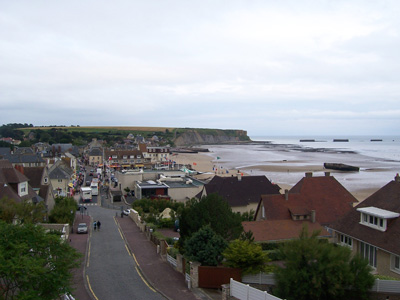
WWII: Maginot Line | Normandy | V-Weapon Sites | Arnhem
Further afield: Crete
| Home Tracing Military Ancestors Travel Advice CWGC Cemeteries Iron Harvest News Book Reviews Glossary Links Contact Me Normandy Landings:
 
|
Location 2 – Arromanches-les-Bains and remains of the Mulberry HarbourDirections – Return to the village of Longues-sur-Mer and turn left at the traffic lights onto the D514 in the direction of Arromanches-les-Bains. Continue through the villages of Manvieux and Tracy-sur-Mer taking the last exit off the roundabout to Arromanches-les-Bains. Follow the signs to "Centre Ville" bearing right onto the D87. This will take you past the car park at the top of the town which is the easiest place to park. A car park exists on the seafront but this gets very busy and congested. Arromanches is now a beautiful seaside town and makes a good place to stop for lunch.
Arromanches-les-Bains – The high cliffs forming an arc around Arromanches precluded it from being a main landing beach but made it ideal for the siting of one of the most incredible innovations of the D-Day landings – the Mulberry Harbours. With their individual component sections distributed up and down the English coast from Weymouth to Essex, the Germans never suspected that the Allies would forego the early capture of a heavily defended port by bringing their own ports with them in kit form. But, once the Allies were established ashore on the evening of D-Day, the first of the massive concrete caissons, blockships, pontoons and pierheads that would form two ports, each the size of Dover Harbour, left for France. At 1350 hours on 7th June, whilst the British 50th Division that had come ashore on GOLD beach further to the east was still engaging German defences around the town, the first of the blockships, HMS Alynbank, was scuttled to form the harbour breakwater. The first caissons arrived on 10th June and by the 14th, just 8 days after D-Day itself, the first supplies were being unloaded. Unfortunately, starting on 19th June, an immense storm blew in from the east and during three days of awful weather which gusted to Force 9, the American Mulberry at OMAHA Beach was almost totally wrecked and the British Mulberry B, at Arromanches, was damaged. However, largely because of the fact that the British blockships had been sunk in shallower water, closer together, and the whole harbour structure better anchored, the damage here was quickly repaired and the port continued to function, bringing in thousands of tons of supplies for the Allied effort. After the war, much of the harbour was recycled and today just the concrete caissons forming the outer harbour wall and some thirteen pontoons lying on the beach are left to remind the visitor of one of the greatest engineering achievements in military history.
D-Day Museum Arromanches – Located on the seafront overlooking the remains of the Mulberry Harbour. See the museums page for details. Photos 6 to 10 above show some of the interesting military vehicles and weaponry that can be seen outside the museum. |
